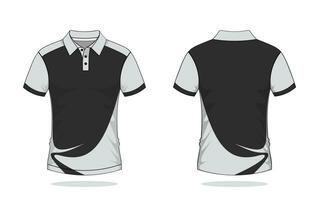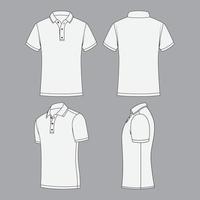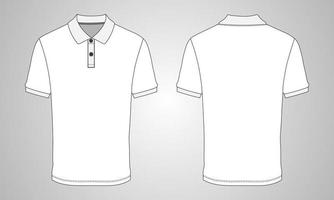The humble polo shirt. It’s a staple in wardrobes worldwide, effortlessly bridging the gap between casual comfort and smart-casual sophistication. From corporate uniforms to sports teams, fashion brands, and personal projects, the polo shirt offers a versatile canvas for design. But if you’ve ever tried to design one from scratch in a powerful program like Adobe Illustrator, you know it can be a time-consuming and sometimes daunting task. This is where the magic of polo shirt design templates comes into play. These pre-built, editable files are not just shortcuts; they are powerful tools that can ignite your creativity, streamline your workflow, and help you bring your vision to life with professional precision. If you're looking to visualize, customize, and perfect your polo shirt concepts, diving into the world of Illustrator templates is your next essential step.
In this comprehensive guide, we'll explore why these templates are indispensable, what to look for when choosing one, how to effectively use them to craft stunning designs, and where to find the best resources. Get ready to transform your design process and create polo shirts that truly stand out.
Why Polo Shirt Design Templates are a Game-Changer for Designers
Whether you're a seasoned graphic designer or just starting your journey, polo shirt design templates offer a multitude of benefits that can significantly enhance your creative process. They act as a robust foundation, allowing you to focus on the aesthetics and branding rather than the intricate technical drawing of the garment itself. This efficiency is paramount in today's fast-paced design world.
Firstly, templates are incredible time-savers. Drawing a polo shirt accurately, with all its seams, collars, plackets, and cuffs, requires a keen eye for detail and a solid understanding of garment construction. A well-designed template provides all these elements pre-drawn and perfectly proportioned, instantly cutting hours off your design time. You can jump straight into experimenting with colors, logos, and patterns.
Secondly, they ensure a professional and consistent look. Even if you're not an expert in fashion illustration, a high-quality template will give your designs a polished, industry-standard appearance. This consistency is crucial for branding, ensuring that your mockups accurately represent the final product and convey professionalism to clients or manufacturers. It eliminates the guesswork and provides a reliable framework.
Furthermore, templates serve as an excellent learning tool. By dissecting the layers and components of a pre-made design, you can gain insights into how professional illustrators construct garments. You'll learn about proper proportions, the placement of design elements, and how different parts of the shirt are assembled, all while customizing it to your liking. They are a launchpad for creativity, providing a structured starting point from which you can explore endless possibilities without feeling overwhelmed by a blank canvas.
What to Look for in a Quality Illustrator Polo Shirt Template
Not all templates are created equal. To get the most out of your design experience, it's crucial to select templates that are well-constructed and user-friendly. Here are the key features to prioritize when you're on the hunt for the perfect polo shirt design template:
The most important characteristic is that the template should be **vector-based**. Since Illustrator is a vector graphics editor, this is usually a given, but it's worth confirming. Vector files (like .AI or .EPS) can be scaled up or down infinitely without any loss of quality, which is absolutely essential for print production, whether you're designing for a small embroidered logo or a large all-over print.
Next, look for templates with **well-organized layers and groups**. A good template will have separate layers for different parts of the shirt – the body, sleeves, collar, placket, buttons, and stitching. This meticulous organization makes it incredibly easy to isolate and edit specific elements without affecting others. You should be able to quickly change the color of the collar without accidentally recoloring the entire shirt.
**Comprehensive views** are also highly beneficial. The best templates will offer front, back, and sometimes even side views of the polo shirt. This allows you to present a complete and accurate representation of your design, showing how logos appear on the back, or how sleeve details wrap around the arm. Some advanced templates might even include different fabric textures or stitching options.
Key Elements to Customize in Your Polo Design
Once you have a great template, the real fun begins: customization! Here’s where you can inject your brand’s personality or your unique creative flair into the design:
Color Palettes: Experiment with different color combinations for the main body, sleeves, collar, and placket. Consider your brand's existing palette, current fashion trends, or the specific purpose of the polo (e.g., team colors, corporate identity).
Logos and Branding: Easily place your company logo, team emblem, or custom graphics onto the shirt. Pay attention to placement (chest, sleeve, back neck) and size to ensure visibility and balance.
Patterns and Textures: Add subtle or bold patterns to the fabric, or incorporate textural elements to give a more realistic feel to your design. This could be anything from a classic pique texture to a custom graphic print.
Collar and Placket Details: These small details can make a big difference. Change the color of the collar and placket, add contrasting tipping stripes, or customize the buttons (color, number, material look).
Sleeve Details: Adjust the ribbing on the cuffs, add stripes, or place smaller logos or patches on the sleeves.
Where to Find Excellent Polo Shirt Design Templates
The internet is a treasure trove of resources for designers, and finding quality polo shirt templates is no exception. Here are some of the best places to look:
Online Marketplaces: Platforms like Adobe Stock, Envato Elements, Creative Market, and GraphicRiver are fantastic resources. They host thousands of professionally designed templates, often created by experienced graphic designers. While many require a subscription or a one-time purchase, the quality and variety are usually worth the investment. Always check the licensing terms to ensure you can use the template for your intended purpose (personal, commercial, etc.).
Free Resource Sites: Websites like Freepik, Vecteezy, and sometimes even Behance or Dribbble offer free vector templates. While "free" is appealing, exercise caution. The quality can vary significantly, and licensing agreements might be more restrictive. Always double-check the license for commercial use if you plan to sell your designs or use them for client work.
Design Communities and Forums: Sometimes, designers share their creations or offer freebies within online communities. These can be great for unique finds, but again, verify the quality and licensing before committing to using them.
Tips for Maximizing Your Illustrator Polo Shirt Template Experience
Once you've found your ideal template, here are some tips to help you get the most out of it and streamline your design process:
Familiarize Yourself with Layers: Before you start editing, take a moment to understand how the template's layers are organized. This will save you frustration later when you need to find a specific element.
Experiment with Swatches: Illustrator's Swatches panel is your best friend for color experimentation. Create a custom color palette for your project and apply it to different parts of the polo shirt. Don't be afraid to try bold combinations.
Utilize Mockups: Many templates come with or are easily adaptable to mockup scenes. These allow you to visualize your design on a real-world model or a more realistic garment texture, helping you and your clients see the final product more clearly.
Save Iterations: As you make significant changes, save different versions of your design. Use a naming convention like "Polo_Design_V1," "Polo_Design_V2," etc. This allows you to revert to an earlier stage if you decide a particular direction isn't working.
Understand Licensing: Seriously, always read the license agreement. It dictates how you can use the template and the designs you create with it. Commercial use often requires a specific license.
Learn Basic Illustrator Tools: While templates do much of the heavy lifting, knowing fundamental Illustrator tools (like the Pen tool, Shape tools, Pathfinder, and basic text editing) will empower you to make more precise modifications and add unique touches.
From Template to Tangible: Preparing Your Design for Production
Designing is one thing; getting it ready for manufacturing is another. A great template helps bridge this gap by providing a clear visual representation, but you still need to prepare your files correctly for production:
Finalizing Colors: Convert all colors to the appropriate color mode for printing (e.g., CMYK for process printing, or specify Pantone colors for accurate spot color matching). Ensure consistency across all design elements.
Exporting in Correct Formats: Manufacturers typically require vector files (AI, EPS, PDF) with all fonts outlined (converted to shapes) to prevent font issues. Provide clear instructions on sizing, placement, and any special finishes.
Providing Clear Specifications: Alongside your design file, include a specification sheet detailing fabric types, stitching preferences, button styles, and any other specific requirements for the polo shirt's construction.
Proofreading and Double-Checking: Before sending anything to production, meticulously review your design for any typos, misalignments, or color discrepancies. A small error at this stage can lead to costly mistakes in production.
Conclusion
Polo shirt design templates in Illustrator are invaluable assets for anyone looking to create professional, eye-catching apparel. They offer a powerful combination of efficiency, precision, and creative freedom, allowing designers of all skill levels to quickly visualize and customize their ideas. By leveraging these templates, you can save time, maintain consistency, and focus your energy on the unique aspects of your design, from color palettes and branding to intricate details. This article has guided you through the benefits of using templates, what characteristics to look for in a quality file, where to source them, and essential tips for both designing and preparing your creations for production. Embrace the power of Illustrator templates and unlock a new level of creativity in your polo shirt designs.



